Sainsbury's: Leadership, Management, and Operational Strategies
VerifiedAdded on 2021/02/22
|10
|3172
|42
Report
AI Summary
This report provides an in-depth analysis of Sainsbury's management and operational strategies. It begins with an introduction to the company, its structure, and the products and services it offers. The main body of the report delves into the definition of leaders and managers, their roles, and the differences between leadership and management. It then examines the roles of leaders and managers in various situations, such as labor turnover and miscommunication, supported by motivational and leadership theories like Maslow's hierarchy of needs and transactional leadership theory. The report further explores different leadership theories, including system leadership, situational leadership, and contingent leadership, and how they support sustainability and growth performance within the organization. The report concludes with recommendations for future improvements, offering insights into how Sainsbury's can enhance its management and operational effectiveness. This assignment is available on Desklib, a platform offering AI-based study tools and resources for students.
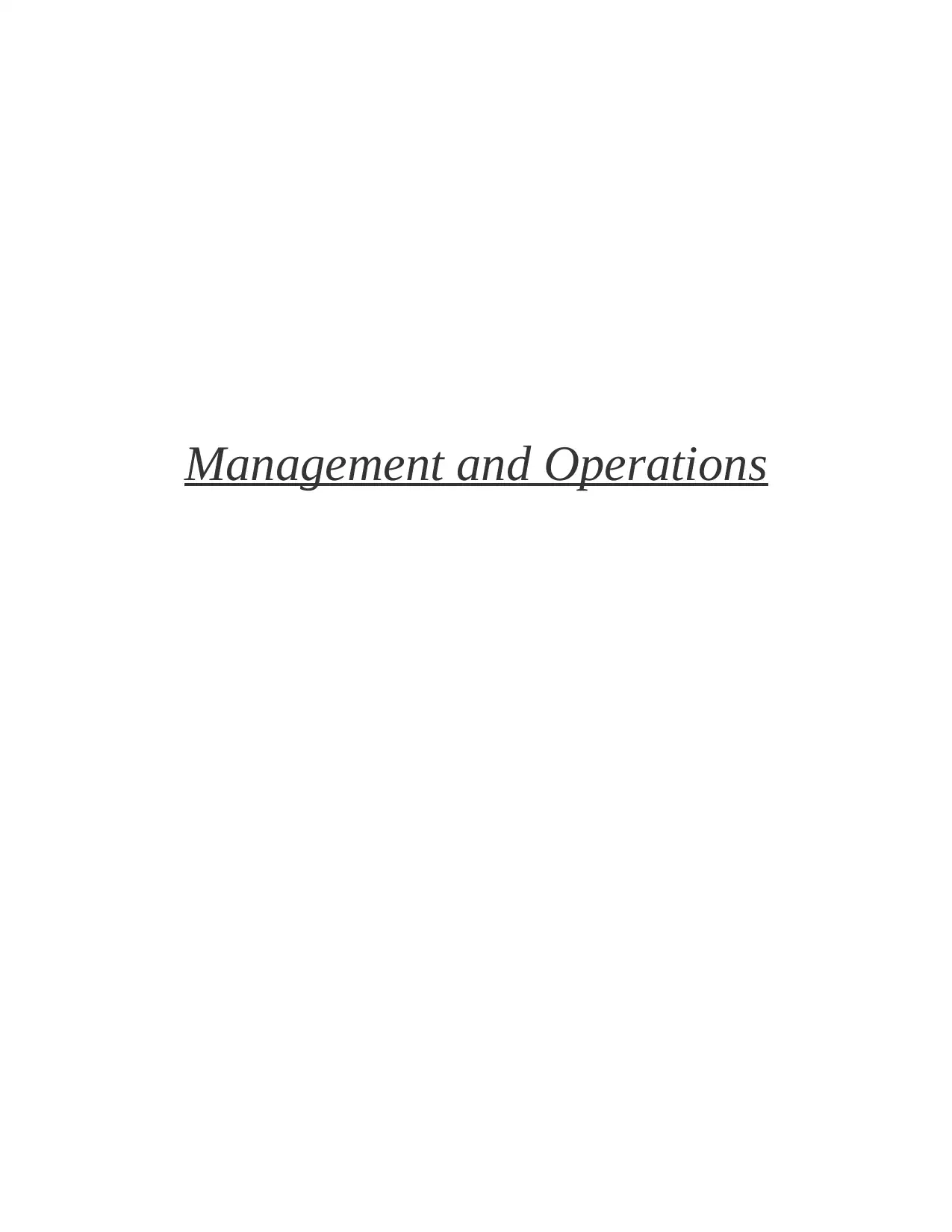
Management and Operations
Paraphrase This Document
Need a fresh take? Get an instant paraphrase of this document with our AI Paraphraser
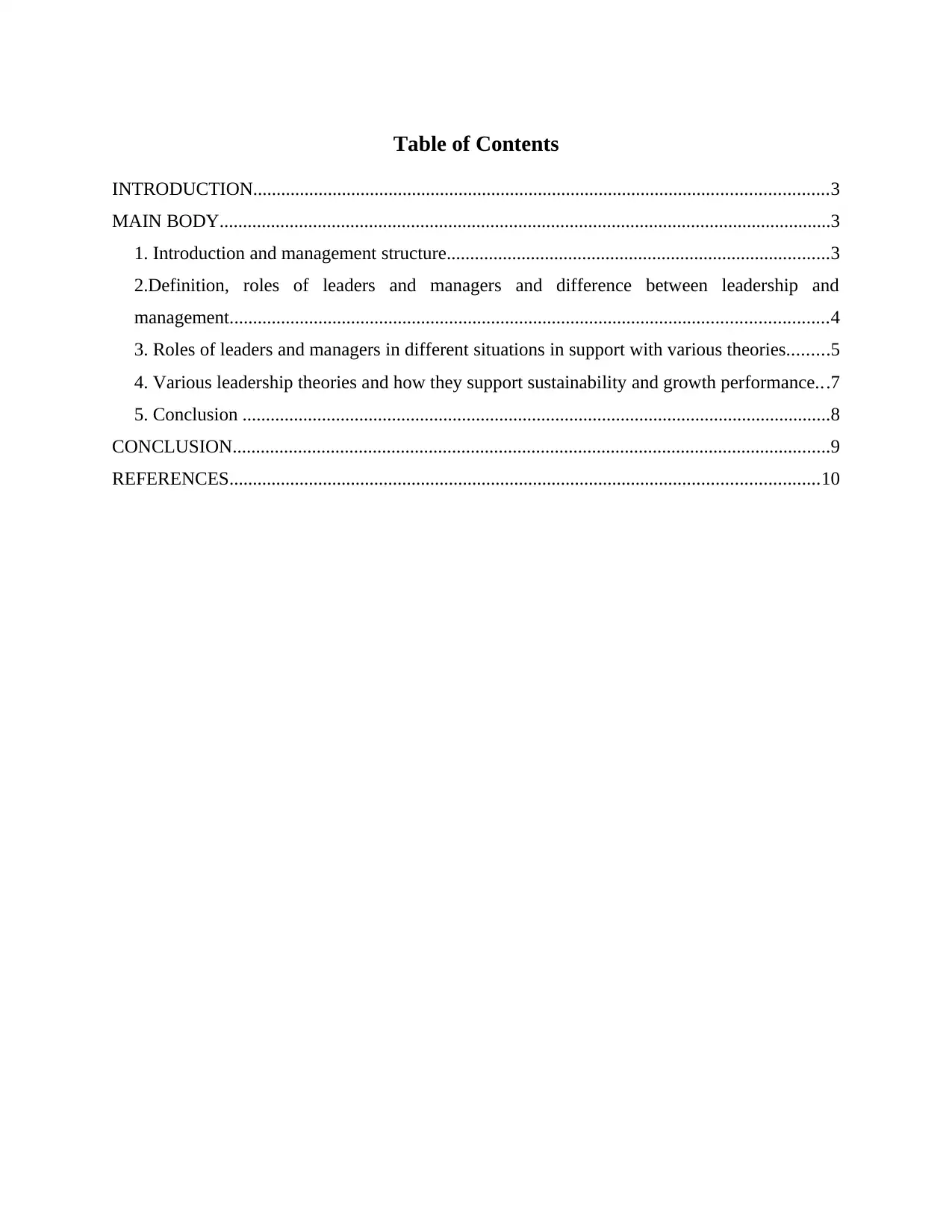
Table of Contents
INTRODUCTION...........................................................................................................................3
MAIN BODY...................................................................................................................................3
1. Introduction and management structure..................................................................................3
2.Definition, roles of leaders and managers and difference between leadership and
management................................................................................................................................4
3. Roles of leaders and managers in different situations in support with various theories.........5
4. Various leadership theories and how they support sustainability and growth performance...7
5. Conclusion ..............................................................................................................................8
CONCLUSION................................................................................................................................9
REFERENCES..............................................................................................................................10
INTRODUCTION...........................................................................................................................3
MAIN BODY...................................................................................................................................3
1. Introduction and management structure..................................................................................3
2.Definition, roles of leaders and managers and difference between leadership and
management................................................................................................................................4
3. Roles of leaders and managers in different situations in support with various theories.........5
4. Various leadership theories and how they support sustainability and growth performance...7
5. Conclusion ..............................................................................................................................8
CONCLUSION................................................................................................................................9
REFERENCES..............................................................................................................................10
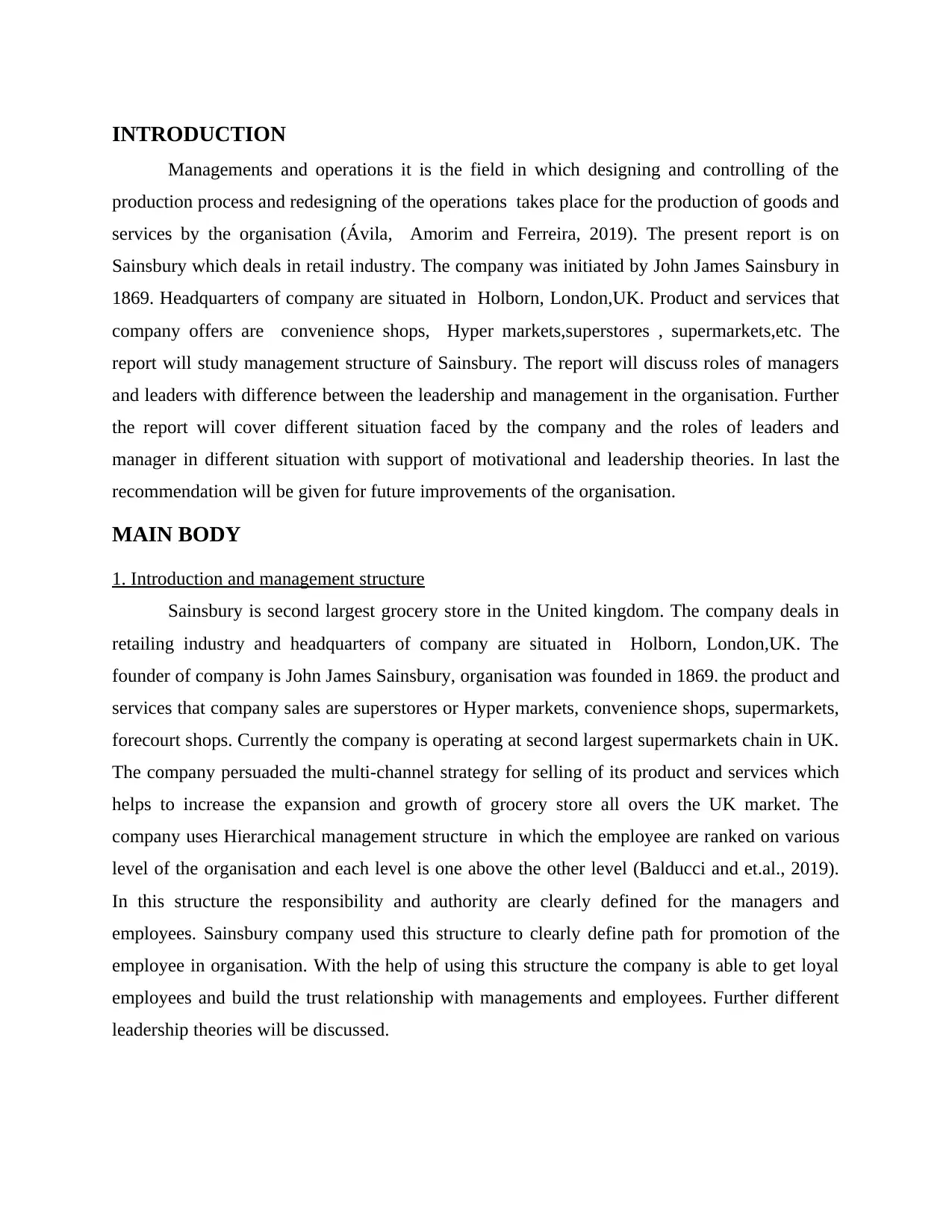
INTRODUCTION
Managements and operations it is the field in which designing and controlling of the
production process and redesigning of the operations takes place for the production of goods and
services by the organisation (Ávila, Amorim and Ferreira, 2019). The present report is on
Sainsbury which deals in retail industry. The company was initiated by John James Sainsbury in
1869. Headquarters of company are situated in Holborn, London,UK. Product and services that
company offers are convenience shops, Hyper markets,superstores , supermarkets,etc. The
report will study management structure of Sainsbury. The report will discuss roles of managers
and leaders with difference between the leadership and management in the organisation. Further
the report will cover different situation faced by the company and the roles of leaders and
manager in different situation with support of motivational and leadership theories. In last the
recommendation will be given for future improvements of the organisation.
MAIN BODY
1. Introduction and management structure
Sainsbury is second largest grocery store in the United kingdom. The company deals in
retailing industry and headquarters of company are situated in Holborn, London,UK. The
founder of company is John James Sainsbury, organisation was founded in 1869. the product and
services that company sales are superstores or Hyper markets, convenience shops, supermarkets,
forecourt shops. Currently the company is operating at second largest supermarkets chain in UK.
The company persuaded the multi-channel strategy for selling of its product and services which
helps to increase the expansion and growth of grocery store all overs the UK market. The
company uses Hierarchical management structure in which the employee are ranked on various
level of the organisation and each level is one above the other level (Balducci and et.al., 2019).
In this structure the responsibility and authority are clearly defined for the managers and
employees. Sainsbury company used this structure to clearly define path for promotion of the
employee in organisation. With the help of using this structure the company is able to get loyal
employees and build the trust relationship with managements and employees. Further different
leadership theories will be discussed.
Managements and operations it is the field in which designing and controlling of the
production process and redesigning of the operations takes place for the production of goods and
services by the organisation (Ávila, Amorim and Ferreira, 2019). The present report is on
Sainsbury which deals in retail industry. The company was initiated by John James Sainsbury in
1869. Headquarters of company are situated in Holborn, London,UK. Product and services that
company offers are convenience shops, Hyper markets,superstores , supermarkets,etc. The
report will study management structure of Sainsbury. The report will discuss roles of managers
and leaders with difference between the leadership and management in the organisation. Further
the report will cover different situation faced by the company and the roles of leaders and
manager in different situation with support of motivational and leadership theories. In last the
recommendation will be given for future improvements of the organisation.
MAIN BODY
1. Introduction and management structure
Sainsbury is second largest grocery store in the United kingdom. The company deals in
retailing industry and headquarters of company are situated in Holborn, London,UK. The
founder of company is John James Sainsbury, organisation was founded in 1869. the product and
services that company sales are superstores or Hyper markets, convenience shops, supermarkets,
forecourt shops. Currently the company is operating at second largest supermarkets chain in UK.
The company persuaded the multi-channel strategy for selling of its product and services which
helps to increase the expansion and growth of grocery store all overs the UK market. The
company uses Hierarchical management structure in which the employee are ranked on various
level of the organisation and each level is one above the other level (Balducci and et.al., 2019).
In this structure the responsibility and authority are clearly defined for the managers and
employees. Sainsbury company used this structure to clearly define path for promotion of the
employee in organisation. With the help of using this structure the company is able to get loyal
employees and build the trust relationship with managements and employees. Further different
leadership theories will be discussed.
⊘ This is a preview!⊘
Do you want full access?
Subscribe today to unlock all pages.

Trusted by 1+ million students worldwide
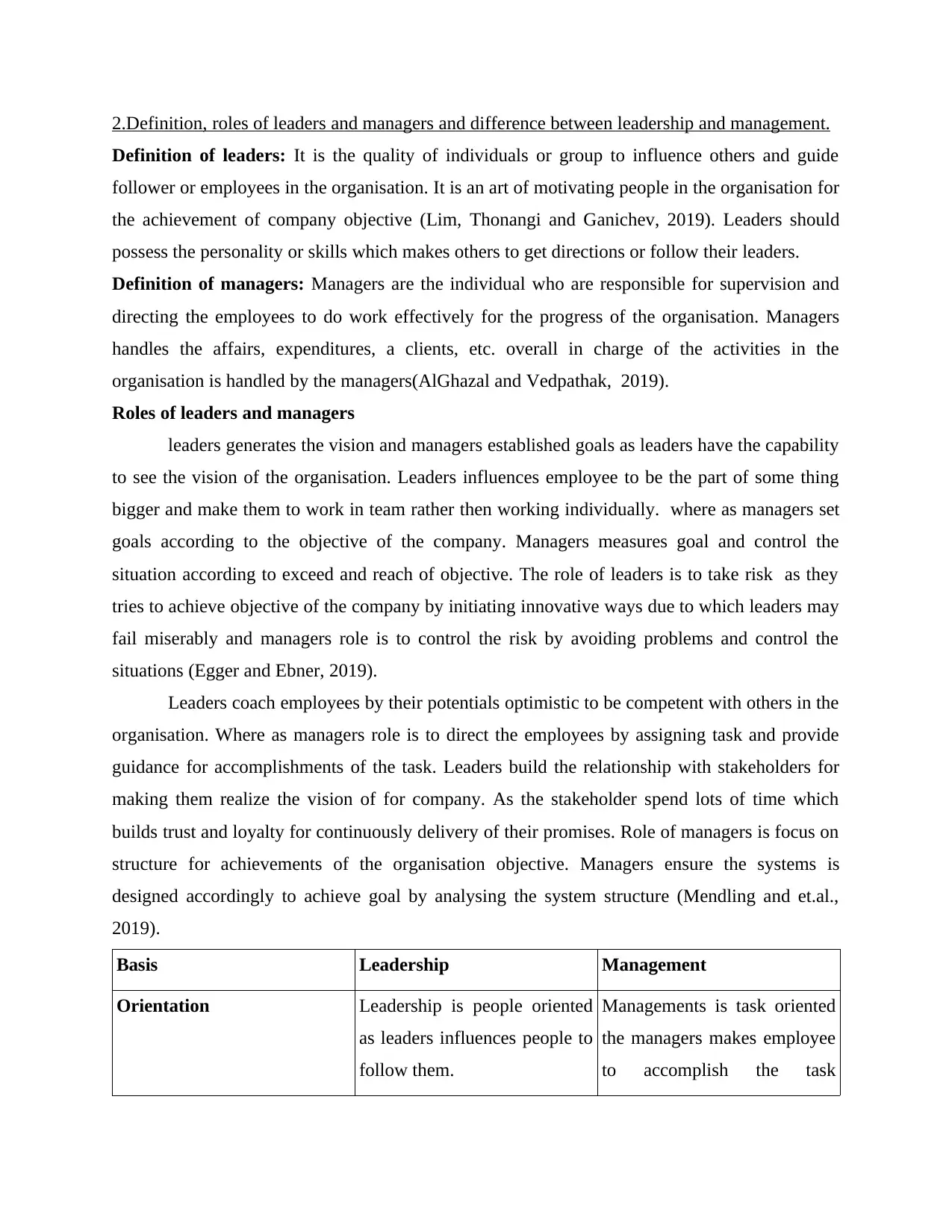
2.Definition, roles of leaders and managers and difference between leadership and management.
Definition of leaders: It is the quality of individuals or group to influence others and guide
follower or employees in the organisation. It is an art of motivating people in the organisation for
the achievement of company objective (Lim, Thonangi and Ganichev, 2019). Leaders should
possess the personality or skills which makes others to get directions or follow their leaders.
Definition of managers: Managers are the individual who are responsible for supervision and
directing the employees to do work effectively for the progress of the organisation. Managers
handles the affairs, expenditures, a clients, etc. overall in charge of the activities in the
organisation is handled by the managers(AlGhazal and Vedpathak, 2019).
Roles of leaders and managers
leaders generates the vision and managers established goals as leaders have the capability
to see the vision of the organisation. Leaders influences employee to be the part of some thing
bigger and make them to work in team rather then working individually. where as managers set
goals according to the objective of the company. Managers measures goal and control the
situation according to exceed and reach of objective. The role of leaders is to take risk as they
tries to achieve objective of the company by initiating innovative ways due to which leaders may
fail miserably and managers role is to control the risk by avoiding problems and control the
situations (Egger and Ebner, 2019).
Leaders coach employees by their potentials optimistic to be competent with others in the
organisation. Where as managers role is to direct the employees by assigning task and provide
guidance for accomplishments of the task. Leaders build the relationship with stakeholders for
making them realize the vision of for company. As the stakeholder spend lots of time which
builds trust and loyalty for continuously delivery of their promises. Role of managers is focus on
structure for achievements of the organisation objective. Managers ensure the systems is
designed accordingly to achieve goal by analysing the system structure (Mendling and et.al.,
2019).
Basis Leadership Management
Orientation Leadership is people oriented
as leaders influences people to
follow them.
Managements is task oriented
the managers makes employee
to accomplish the task
Definition of leaders: It is the quality of individuals or group to influence others and guide
follower or employees in the organisation. It is an art of motivating people in the organisation for
the achievement of company objective (Lim, Thonangi and Ganichev, 2019). Leaders should
possess the personality or skills which makes others to get directions or follow their leaders.
Definition of managers: Managers are the individual who are responsible for supervision and
directing the employees to do work effectively for the progress of the organisation. Managers
handles the affairs, expenditures, a clients, etc. overall in charge of the activities in the
organisation is handled by the managers(AlGhazal and Vedpathak, 2019).
Roles of leaders and managers
leaders generates the vision and managers established goals as leaders have the capability
to see the vision of the organisation. Leaders influences employee to be the part of some thing
bigger and make them to work in team rather then working individually. where as managers set
goals according to the objective of the company. Managers measures goal and control the
situation according to exceed and reach of objective. The role of leaders is to take risk as they
tries to achieve objective of the company by initiating innovative ways due to which leaders may
fail miserably and managers role is to control the risk by avoiding problems and control the
situations (Egger and Ebner, 2019).
Leaders coach employees by their potentials optimistic to be competent with others in the
organisation. Where as managers role is to direct the employees by assigning task and provide
guidance for accomplishments of the task. Leaders build the relationship with stakeholders for
making them realize the vision of for company. As the stakeholder spend lots of time which
builds trust and loyalty for continuously delivery of their promises. Role of managers is focus on
structure for achievements of the organisation objective. Managers ensure the systems is
designed accordingly to achieve goal by analysing the system structure (Mendling and et.al.,
2019).
Basis Leadership Management
Orientation Leadership is people oriented
as leaders influences people to
follow them.
Managements is task oriented
the managers makes employee
to accomplish the task
Paraphrase This Document
Need a fresh take? Get an instant paraphrase of this document with our AI Paraphraser
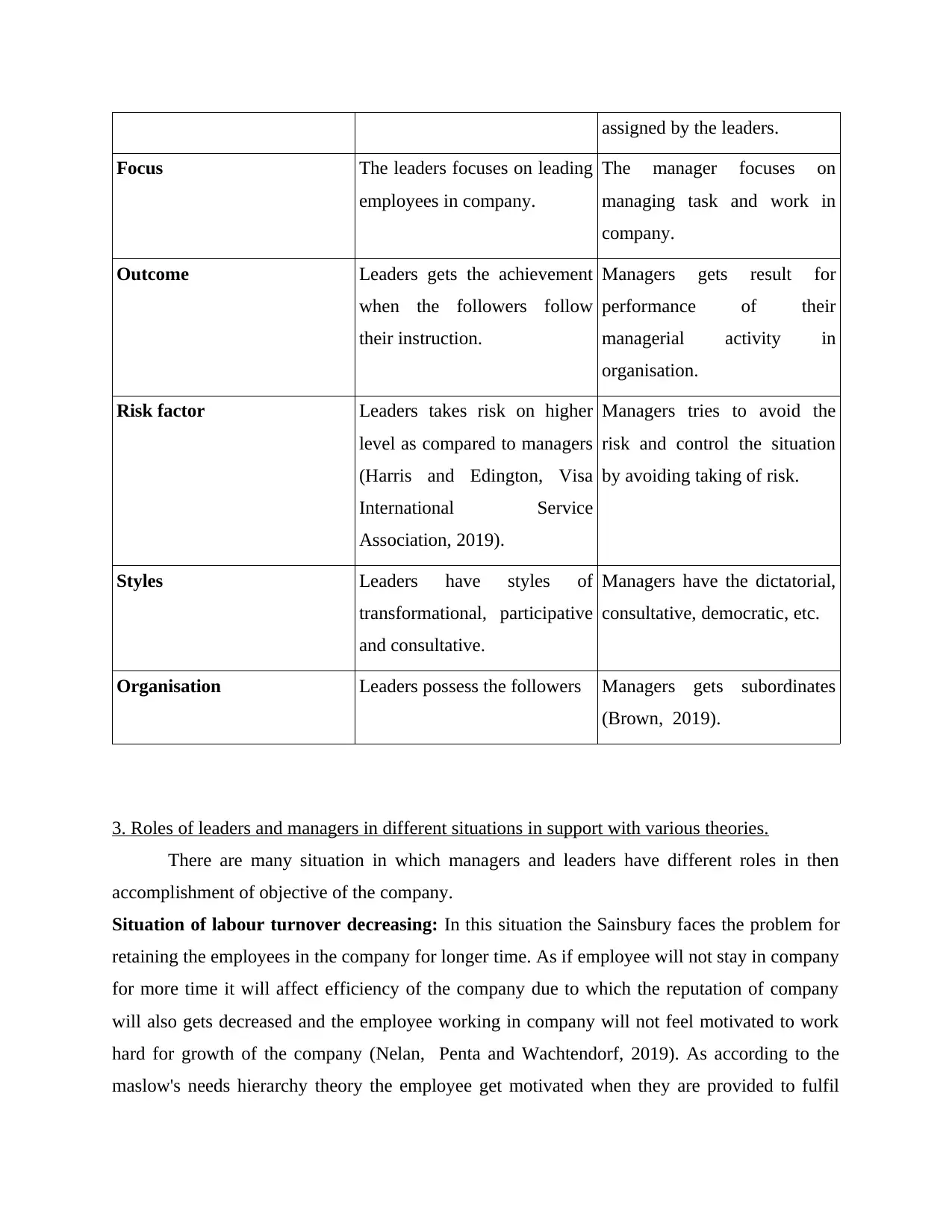
assigned by the leaders.
Focus The leaders focuses on leading
employees in company.
The manager focuses on
managing task and work in
company.
Outcome Leaders gets the achievement
when the followers follow
their instruction.
Managers gets result for
performance of their
managerial activity in
organisation.
Risk factor Leaders takes risk on higher
level as compared to managers
(Harris and Edington, Visa
International Service
Association, 2019).
Managers tries to avoid the
risk and control the situation
by avoiding taking of risk.
Styles Leaders have styles of
transformational, participative
and consultative.
Managers have the dictatorial,
consultative, democratic, etc.
Organisation Leaders possess the followers Managers gets subordinates
(Brown, 2019).
3. Roles of leaders and managers in different situations in support with various theories.
There are many situation in which managers and leaders have different roles in then
accomplishment of objective of the company.
Situation of labour turnover decreasing: In this situation the Sainsbury faces the problem for
retaining the employees in the company for longer time. As if employee will not stay in company
for more time it will affect efficiency of the company due to which the reputation of company
will also gets decreased and the employee working in company will not feel motivated to work
hard for growth of the company (Nelan, Penta and Wachtendorf, 2019). As according to the
maslow's needs hierarchy theory the employee get motivated when they are provided to fulfil
Focus The leaders focuses on leading
employees in company.
The manager focuses on
managing task and work in
company.
Outcome Leaders gets the achievement
when the followers follow
their instruction.
Managers gets result for
performance of their
managerial activity in
organisation.
Risk factor Leaders takes risk on higher
level as compared to managers
(Harris and Edington, Visa
International Service
Association, 2019).
Managers tries to avoid the
risk and control the situation
by avoiding taking of risk.
Styles Leaders have styles of
transformational, participative
and consultative.
Managers have the dictatorial,
consultative, democratic, etc.
Organisation Leaders possess the followers Managers gets subordinates
(Brown, 2019).
3. Roles of leaders and managers in different situations in support with various theories.
There are many situation in which managers and leaders have different roles in then
accomplishment of objective of the company.
Situation of labour turnover decreasing: In this situation the Sainsbury faces the problem for
retaining the employees in the company for longer time. As if employee will not stay in company
for more time it will affect efficiency of the company due to which the reputation of company
will also gets decreased and the employee working in company will not feel motivated to work
hard for growth of the company (Nelan, Penta and Wachtendorf, 2019). As according to the
maslow's needs hierarchy theory the employee get motivated when they are provided to fulfil
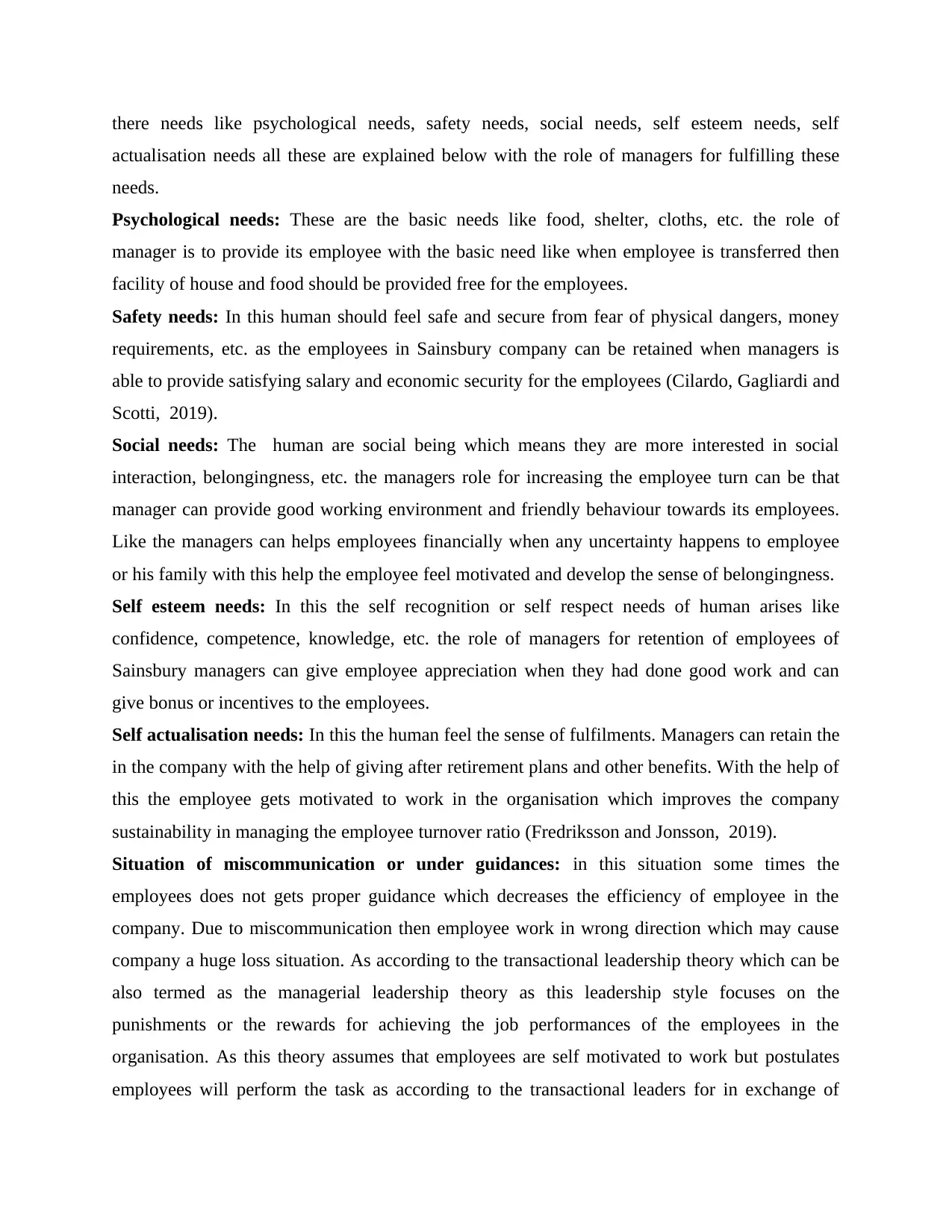
there needs like psychological needs, safety needs, social needs, self esteem needs, self
actualisation needs all these are explained below with the role of managers for fulfilling these
needs.
Psychological needs: These are the basic needs like food, shelter, cloths, etc. the role of
manager is to provide its employee with the basic need like when employee is transferred then
facility of house and food should be provided free for the employees.
Safety needs: In this human should feel safe and secure from fear of physical dangers, money
requirements, etc. as the employees in Sainsbury company can be retained when managers is
able to provide satisfying salary and economic security for the employees (Cilardo, Gagliardi and
Scotti, 2019).
Social needs: The human are social being which means they are more interested in social
interaction, belongingness, etc. the managers role for increasing the employee turn can be that
manager can provide good working environment and friendly behaviour towards its employees.
Like the managers can helps employees financially when any uncertainty happens to employee
or his family with this help the employee feel motivated and develop the sense of belongingness.
Self esteem needs: In this the self recognition or self respect needs of human arises like
confidence, competence, knowledge, etc. the role of managers for retention of employees of
Sainsbury managers can give employee appreciation when they had done good work and can
give bonus or incentives to the employees.
Self actualisation needs: In this the human feel the sense of fulfilments. Managers can retain the
in the company with the help of giving after retirement plans and other benefits. With the help of
this the employee gets motivated to work in the organisation which improves the company
sustainability in managing the employee turnover ratio (Fredriksson and Jonsson, 2019).
Situation of miscommunication or under guidances: in this situation some times the
employees does not gets proper guidance which decreases the efficiency of employee in the
company. Due to miscommunication then employee work in wrong direction which may cause
company a huge loss situation. As according to the transactional leadership theory which can be
also termed as the managerial leadership theory as this leadership style focuses on the
punishments or the rewards for achieving the job performances of the employees in the
organisation. As this theory assumes that employees are self motivated to work but postulates
employees will perform the task as according to the transactional leaders for in exchange of
actualisation needs all these are explained below with the role of managers for fulfilling these
needs.
Psychological needs: These are the basic needs like food, shelter, cloths, etc. the role of
manager is to provide its employee with the basic need like when employee is transferred then
facility of house and food should be provided free for the employees.
Safety needs: In this human should feel safe and secure from fear of physical dangers, money
requirements, etc. as the employees in Sainsbury company can be retained when managers is
able to provide satisfying salary and economic security for the employees (Cilardo, Gagliardi and
Scotti, 2019).
Social needs: The human are social being which means they are more interested in social
interaction, belongingness, etc. the managers role for increasing the employee turn can be that
manager can provide good working environment and friendly behaviour towards its employees.
Like the managers can helps employees financially when any uncertainty happens to employee
or his family with this help the employee feel motivated and develop the sense of belongingness.
Self esteem needs: In this the self recognition or self respect needs of human arises like
confidence, competence, knowledge, etc. the role of managers for retention of employees of
Sainsbury managers can give employee appreciation when they had done good work and can
give bonus or incentives to the employees.
Self actualisation needs: In this the human feel the sense of fulfilments. Managers can retain the
in the company with the help of giving after retirement plans and other benefits. With the help of
this the employee gets motivated to work in the organisation which improves the company
sustainability in managing the employee turnover ratio (Fredriksson and Jonsson, 2019).
Situation of miscommunication or under guidances: in this situation some times the
employees does not gets proper guidance which decreases the efficiency of employee in the
company. Due to miscommunication then employee work in wrong direction which may cause
company a huge loss situation. As according to the transactional leadership theory which can be
also termed as the managerial leadership theory as this leadership style focuses on the
punishments or the rewards for achieving the job performances of the employees in the
organisation. As this theory assumes that employees are self motivated to work but postulates
employees will perform the task as according to the transactional leaders for in exchange of
⊘ This is a preview!⊘
Do you want full access?
Subscribe today to unlock all pages.

Trusted by 1+ million students worldwide
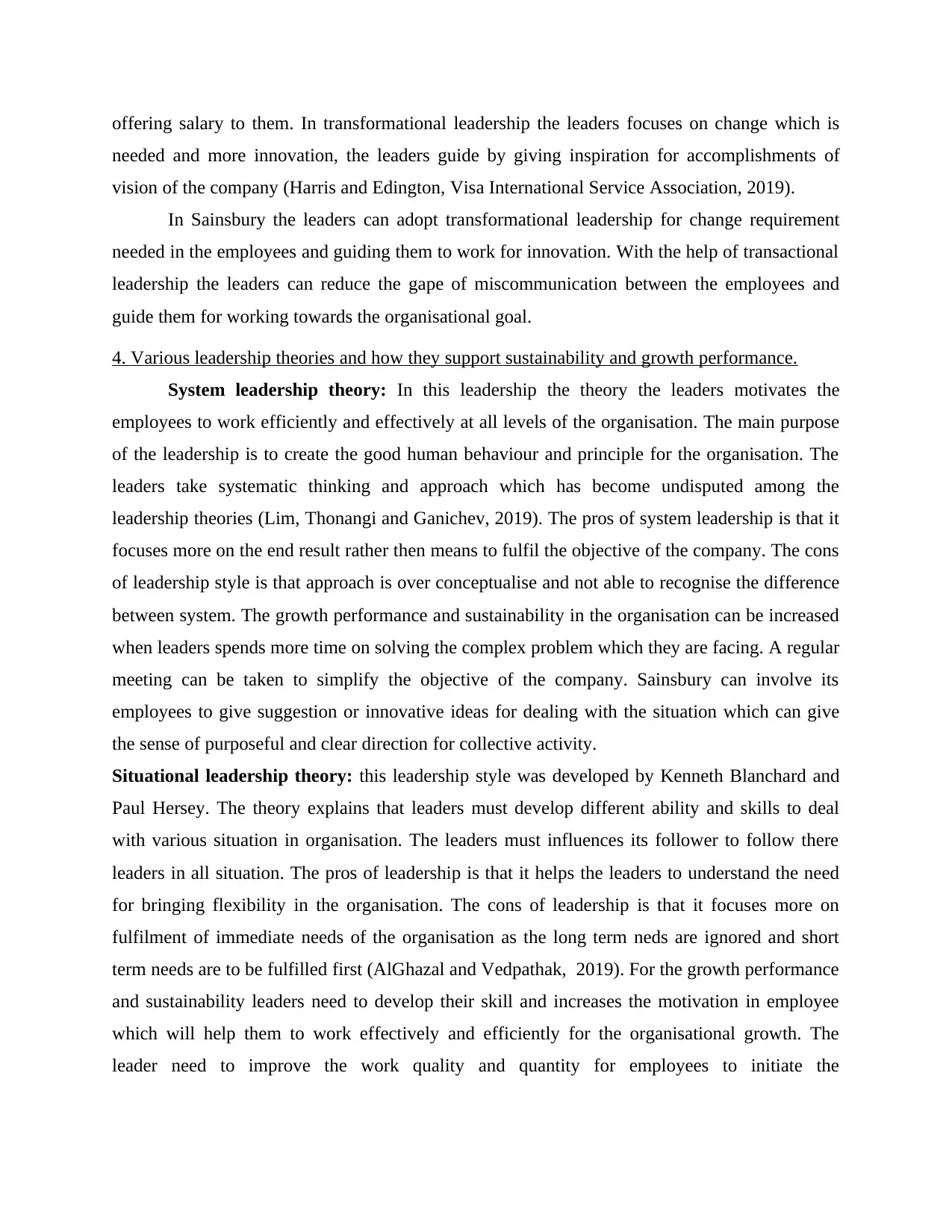
offering salary to them. In transformational leadership the leaders focuses on change which is
needed and more innovation, the leaders guide by giving inspiration for accomplishments of
vision of the company (Harris and Edington, Visa International Service Association, 2019).
In Sainsbury the leaders can adopt transformational leadership for change requirement
needed in the employees and guiding them to work for innovation. With the help of transactional
leadership the leaders can reduce the gape of miscommunication between the employees and
guide them for working towards the organisational goal.
4. Various leadership theories and how they support sustainability and growth performance.
System leadership theory: In this leadership the theory the leaders motivates the
employees to work efficiently and effectively at all levels of the organisation. The main purpose
of the leadership is to create the good human behaviour and principle for the organisation. The
leaders take systematic thinking and approach which has become undisputed among the
leadership theories (Lim, Thonangi and Ganichev, 2019). The pros of system leadership is that it
focuses more on the end result rather then means to fulfil the objective of the company. The cons
of leadership style is that approach is over conceptualise and not able to recognise the difference
between system. The growth performance and sustainability in the organisation can be increased
when leaders spends more time on solving the complex problem which they are facing. A regular
meeting can be taken to simplify the objective of the company. Sainsbury can involve its
employees to give suggestion or innovative ideas for dealing with the situation which can give
the sense of purposeful and clear direction for collective activity.
Situational leadership theory: this leadership style was developed by Kenneth Blanchard and
Paul Hersey. The theory explains that leaders must develop different ability and skills to deal
with various situation in organisation. The leaders must influences its follower to follow there
leaders in all situation. The pros of leadership is that it helps the leaders to understand the need
for bringing flexibility in the organisation. The cons of leadership is that it focuses more on
fulfilment of immediate needs of the organisation as the long term neds are ignored and short
term needs are to be fulfilled first (AlGhazal and Vedpathak, 2019). For the growth performance
and sustainability leaders need to develop their skill and increases the motivation in employee
which will help them to work effectively and efficiently for the organisational growth. The
leader need to improve the work quality and quantity for employees to initiate the
needed and more innovation, the leaders guide by giving inspiration for accomplishments of
vision of the company (Harris and Edington, Visa International Service Association, 2019).
In Sainsbury the leaders can adopt transformational leadership for change requirement
needed in the employees and guiding them to work for innovation. With the help of transactional
leadership the leaders can reduce the gape of miscommunication between the employees and
guide them for working towards the organisational goal.
4. Various leadership theories and how they support sustainability and growth performance.
System leadership theory: In this leadership the theory the leaders motivates the
employees to work efficiently and effectively at all levels of the organisation. The main purpose
of the leadership is to create the good human behaviour and principle for the organisation. The
leaders take systematic thinking and approach which has become undisputed among the
leadership theories (Lim, Thonangi and Ganichev, 2019). The pros of system leadership is that it
focuses more on the end result rather then means to fulfil the objective of the company. The cons
of leadership style is that approach is over conceptualise and not able to recognise the difference
between system. The growth performance and sustainability in the organisation can be increased
when leaders spends more time on solving the complex problem which they are facing. A regular
meeting can be taken to simplify the objective of the company. Sainsbury can involve its
employees to give suggestion or innovative ideas for dealing with the situation which can give
the sense of purposeful and clear direction for collective activity.
Situational leadership theory: this leadership style was developed by Kenneth Blanchard and
Paul Hersey. The theory explains that leaders must develop different ability and skills to deal
with various situation in organisation. The leaders must influences its follower to follow there
leaders in all situation. The pros of leadership is that it helps the leaders to understand the need
for bringing flexibility in the organisation. The cons of leadership is that it focuses more on
fulfilment of immediate needs of the organisation as the long term neds are ignored and short
term needs are to be fulfilled first (AlGhazal and Vedpathak, 2019). For the growth performance
and sustainability leaders need to develop their skill and increases the motivation in employee
which will help them to work effectively and efficiently for the organisational growth. The
leader need to improve the work quality and quantity for employees to initiate the
Paraphrase This Document
Need a fresh take? Get an instant paraphrase of this document with our AI Paraphraser
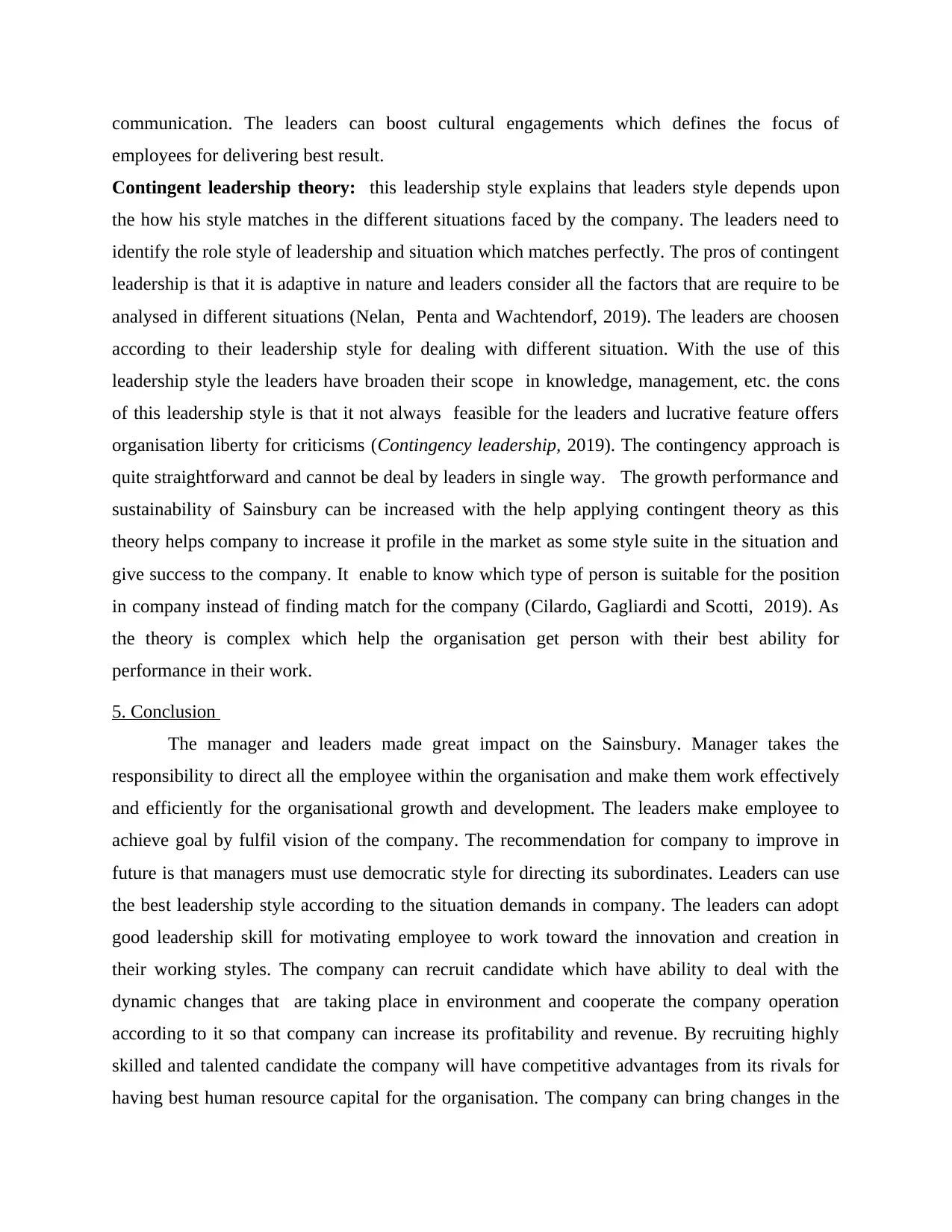
communication. The leaders can boost cultural engagements which defines the focus of
employees for delivering best result.
Contingent leadership theory: this leadership style explains that leaders style depends upon
the how his style matches in the different situations faced by the company. The leaders need to
identify the role style of leadership and situation which matches perfectly. The pros of contingent
leadership is that it is adaptive in nature and leaders consider all the factors that are require to be
analysed in different situations (Nelan, Penta and Wachtendorf, 2019). The leaders are choosen
according to their leadership style for dealing with different situation. With the use of this
leadership style the leaders have broaden their scope in knowledge, management, etc. the cons
of this leadership style is that it not always feasible for the leaders and lucrative feature offers
organisation liberty for criticisms (Contingency leadership, 2019). The contingency approach is
quite straightforward and cannot be deal by leaders in single way. The growth performance and
sustainability of Sainsbury can be increased with the help applying contingent theory as this
theory helps company to increase it profile in the market as some style suite in the situation and
give success to the company. It enable to know which type of person is suitable for the position
in company instead of finding match for the company (Cilardo, Gagliardi and Scotti, 2019). As
the theory is complex which help the organisation get person with their best ability for
performance in their work.
5. Conclusion
The manager and leaders made great impact on the Sainsbury. Manager takes the
responsibility to direct all the employee within the organisation and make them work effectively
and efficiently for the organisational growth and development. The leaders make employee to
achieve goal by fulfil vision of the company. The recommendation for company to improve in
future is that managers must use democratic style for directing its subordinates. Leaders can use
the best leadership style according to the situation demands in company. The leaders can adopt
good leadership skill for motivating employee to work toward the innovation and creation in
their working styles. The company can recruit candidate which have ability to deal with the
dynamic changes that are taking place in environment and cooperate the company operation
according to it so that company can increase its profitability and revenue. By recruiting highly
skilled and talented candidate the company will have competitive advantages from its rivals for
having best human resource capital for the organisation. The company can bring changes in the
employees for delivering best result.
Contingent leadership theory: this leadership style explains that leaders style depends upon
the how his style matches in the different situations faced by the company. The leaders need to
identify the role style of leadership and situation which matches perfectly. The pros of contingent
leadership is that it is adaptive in nature and leaders consider all the factors that are require to be
analysed in different situations (Nelan, Penta and Wachtendorf, 2019). The leaders are choosen
according to their leadership style for dealing with different situation. With the use of this
leadership style the leaders have broaden their scope in knowledge, management, etc. the cons
of this leadership style is that it not always feasible for the leaders and lucrative feature offers
organisation liberty for criticisms (Contingency leadership, 2019). The contingency approach is
quite straightforward and cannot be deal by leaders in single way. The growth performance and
sustainability of Sainsbury can be increased with the help applying contingent theory as this
theory helps company to increase it profile in the market as some style suite in the situation and
give success to the company. It enable to know which type of person is suitable for the position
in company instead of finding match for the company (Cilardo, Gagliardi and Scotti, 2019). As
the theory is complex which help the organisation get person with their best ability for
performance in their work.
5. Conclusion
The manager and leaders made great impact on the Sainsbury. Manager takes the
responsibility to direct all the employee within the organisation and make them work effectively
and efficiently for the organisational growth and development. The leaders make employee to
achieve goal by fulfil vision of the company. The recommendation for company to improve in
future is that managers must use democratic style for directing its subordinates. Leaders can use
the best leadership style according to the situation demands in company. The leaders can adopt
good leadership skill for motivating employee to work toward the innovation and creation in
their working styles. The company can recruit candidate which have ability to deal with the
dynamic changes that are taking place in environment and cooperate the company operation
according to it so that company can increase its profitability and revenue. By recruiting highly
skilled and talented candidate the company will have competitive advantages from its rivals for
having best human resource capital for the organisation. The company can bring changes in the
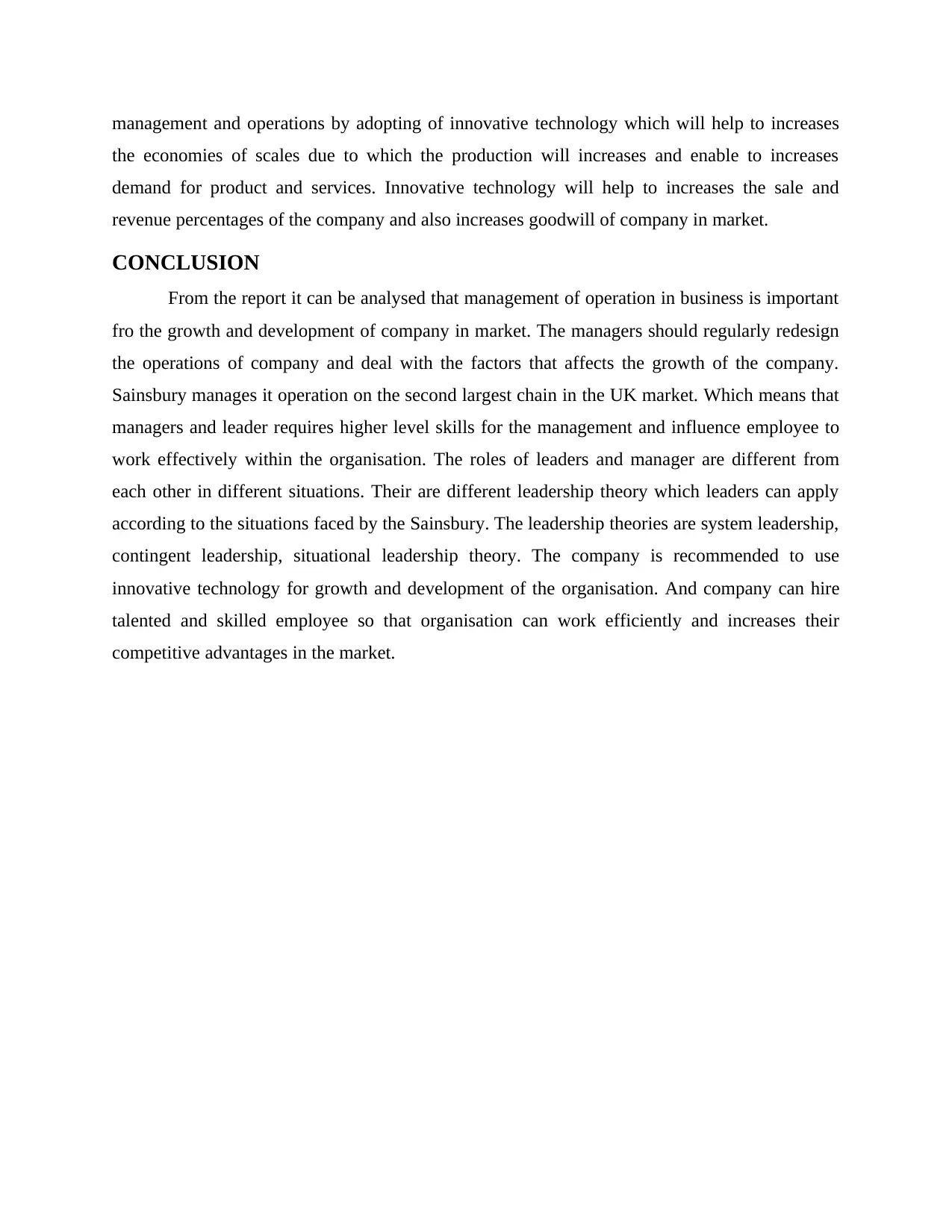
management and operations by adopting of innovative technology which will help to increases
the economies of scales due to which the production will increases and enable to increases
demand for product and services. Innovative technology will help to increases the sale and
revenue percentages of the company and also increases goodwill of company in market.
CONCLUSION
From the report it can be analysed that management of operation in business is important
fro the growth and development of company in market. The managers should regularly redesign
the operations of company and deal with the factors that affects the growth of the company.
Sainsbury manages it operation on the second largest chain in the UK market. Which means that
managers and leader requires higher level skills for the management and influence employee to
work effectively within the organisation. The roles of leaders and manager are different from
each other in different situations. Their are different leadership theory which leaders can apply
according to the situations faced by the Sainsbury. The leadership theories are system leadership,
contingent leadership, situational leadership theory. The company is recommended to use
innovative technology for growth and development of the organisation. And company can hire
talented and skilled employee so that organisation can work efficiently and increases their
competitive advantages in the market.
the economies of scales due to which the production will increases and enable to increases
demand for product and services. Innovative technology will help to increases the sale and
revenue percentages of the company and also increases goodwill of company in market.
CONCLUSION
From the report it can be analysed that management of operation in business is important
fro the growth and development of company in market. The managers should regularly redesign
the operations of company and deal with the factors that affects the growth of the company.
Sainsbury manages it operation on the second largest chain in the UK market. Which means that
managers and leader requires higher level skills for the management and influence employee to
work effectively within the organisation. The roles of leaders and manager are different from
each other in different situations. Their are different leadership theory which leaders can apply
according to the situations faced by the Sainsbury. The leadership theories are system leadership,
contingent leadership, situational leadership theory. The company is recommended to use
innovative technology for growth and development of the organisation. And company can hire
talented and skilled employee so that organisation can work efficiently and increases their
competitive advantages in the market.
⊘ This is a preview!⊘
Do you want full access?
Subscribe today to unlock all pages.

Trusted by 1+ million students worldwide
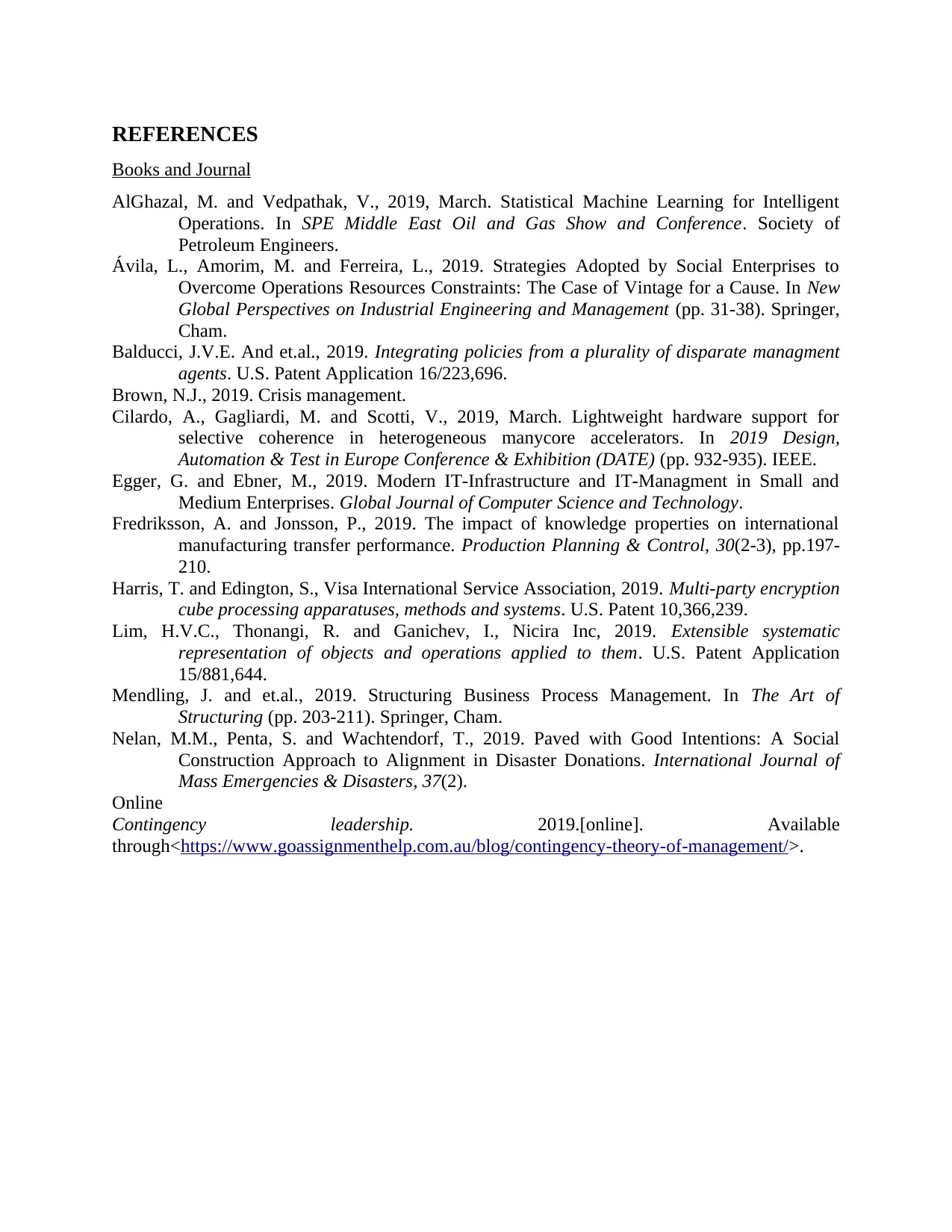
REFERENCES
Books and Journal
AlGhazal, M. and Vedpathak, V., 2019, March. Statistical Machine Learning for Intelligent
Operations. In SPE Middle East Oil and Gas Show and Conference. Society of
Petroleum Engineers.
Ávila, L., Amorim, M. and Ferreira, L., 2019. Strategies Adopted by Social Enterprises to
Overcome Operations Resources Constraints: The Case of Vintage for a Cause. In New
Global Perspectives on Industrial Engineering and Management (pp. 31-38). Springer,
Cham.
Balducci, J.V.E. And et.al., 2019. Integrating policies from a plurality of disparate managment
agents. U.S. Patent Application 16/223,696.
Brown, N.J., 2019. Crisis management.
Cilardo, A., Gagliardi, M. and Scotti, V., 2019, March. Lightweight hardware support for
selective coherence in heterogeneous manycore accelerators. In 2019 Design,
Automation & Test in Europe Conference & Exhibition (DATE) (pp. 932-935). IEEE.
Egger, G. and Ebner, M., 2019. Modern IT-Infrastructure and IT-Managment in Small and
Medium Enterprises. Global Journal of Computer Science and Technology.
Fredriksson, A. and Jonsson, P., 2019. The impact of knowledge properties on international
manufacturing transfer performance. Production Planning & Control, 30(2-3), pp.197-
210.
Harris, T. and Edington, S., Visa International Service Association, 2019. Multi-party encryption
cube processing apparatuses, methods and systems. U.S. Patent 10,366,239.
Lim, H.V.C., Thonangi, R. and Ganichev, I., Nicira Inc, 2019. Extensible systematic
representation of objects and operations applied to them. U.S. Patent Application
15/881,644.
Mendling, J. and et.al., 2019. Structuring Business Process Management. In The Art of
Structuring (pp. 203-211). Springer, Cham.
Nelan, M.M., Penta, S. and Wachtendorf, T., 2019. Paved with Good Intentions: A Social
Construction Approach to Alignment in Disaster Donations. International Journal of
Mass Emergencies & Disasters, 37(2).
Online
Contingency leadership. 2019.[online]. Available
through<https://www.goassignmenthelp.com.au/blog/contingency-theory-of-management/>.
Books and Journal
AlGhazal, M. and Vedpathak, V., 2019, March. Statistical Machine Learning for Intelligent
Operations. In SPE Middle East Oil and Gas Show and Conference. Society of
Petroleum Engineers.
Ávila, L., Amorim, M. and Ferreira, L., 2019. Strategies Adopted by Social Enterprises to
Overcome Operations Resources Constraints: The Case of Vintage for a Cause. In New
Global Perspectives on Industrial Engineering and Management (pp. 31-38). Springer,
Cham.
Balducci, J.V.E. And et.al., 2019. Integrating policies from a plurality of disparate managment
agents. U.S. Patent Application 16/223,696.
Brown, N.J., 2019. Crisis management.
Cilardo, A., Gagliardi, M. and Scotti, V., 2019, March. Lightweight hardware support for
selective coherence in heterogeneous manycore accelerators. In 2019 Design,
Automation & Test in Europe Conference & Exhibition (DATE) (pp. 932-935). IEEE.
Egger, G. and Ebner, M., 2019. Modern IT-Infrastructure and IT-Managment in Small and
Medium Enterprises. Global Journal of Computer Science and Technology.
Fredriksson, A. and Jonsson, P., 2019. The impact of knowledge properties on international
manufacturing transfer performance. Production Planning & Control, 30(2-3), pp.197-
210.
Harris, T. and Edington, S., Visa International Service Association, 2019. Multi-party encryption
cube processing apparatuses, methods and systems. U.S. Patent 10,366,239.
Lim, H.V.C., Thonangi, R. and Ganichev, I., Nicira Inc, 2019. Extensible systematic
representation of objects and operations applied to them. U.S. Patent Application
15/881,644.
Mendling, J. and et.al., 2019. Structuring Business Process Management. In The Art of
Structuring (pp. 203-211). Springer, Cham.
Nelan, M.M., Penta, S. and Wachtendorf, T., 2019. Paved with Good Intentions: A Social
Construction Approach to Alignment in Disaster Donations. International Journal of
Mass Emergencies & Disasters, 37(2).
Online
Contingency leadership. 2019.[online]. Available
through<https://www.goassignmenthelp.com.au/blog/contingency-theory-of-management/>.
1 out of 10
Related Documents
Your All-in-One AI-Powered Toolkit for Academic Success.
+13062052269
info@desklib.com
Available 24*7 on WhatsApp / Email
![[object Object]](/_next/static/media/star-bottom.7253800d.svg)
Unlock your academic potential
Copyright © 2020–2025 A2Z Services. All Rights Reserved. Developed and managed by ZUCOL.




